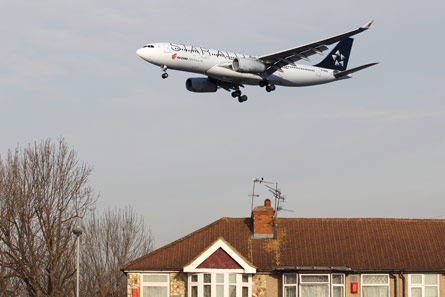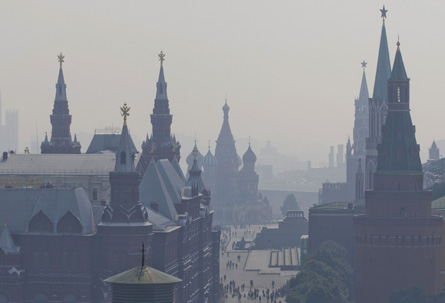During the past few months the European Union has suffered blow after blow over its decision to include aviation in its emissions trading system. Ask people why they are so against the EU ETS and the response is likely to include the words "global solution" and "ICAO". They will argue that, as a global industry, aviation's carbon dioxide (CO2) emissions should be regulated at a global level, not via regional schemes. And they will pitch the International Civil Aviation Organisation as the best platform through which to produce such a system.
Even the European Commission supports this line of reasoning, despite standing firm behind its regional cap-and-trade scheme. "It is in the strong interests of the European Union to support this process and actively engage with all partners willing to find a global solution," says Mary Veronica Tovsak Pleterski, director for European and international carbon markets in the Commission's climate-action unit. She says the Commission has agreed to review the inclusion of aviation in the ETS if and when a global solution is reached. However, she also insists the EU was right to act now to tackle aviation emissions rather than waiting for ICAO. "Climate change is an urgent problem. Inaction today would create significant costs for future generations," she says.
 |
|---|
© AirTeamImages In February, China issued a directive banning its airlines from complying with the ETS |
And there lies the rub: ICAO is a United Nations agency with 191 members. It has struggled for more than a decade to come up with a global framework for regulating the aviation industry's CO2 emissions - and the EU remains openly sceptical about its short-term chances of success.
In 2004, ICAO formally adopted the goal to limit or reduce the impact of aviation emissions on the global climate, but even then it did not propose a new legal instrument. Instead, after years of fruitless discussions, the ICAO endorsed the possibility its member states could incorporate international aviation in their general emissions trading schemes. "The EU's decision to include aviation in the EU ETS was taken after ICAO explicitly decided in 2004 not to pursue a global instrument of its own," says Pleterski. Aviation's inclusion in the ETS passed into law in 2008 and became effective as of 1 January 2012.
However, this argument did not wash with non-EU countries. Many were angered by what they saw as the unilateral enforcement of EU law. The backlash was swift and continues to gain force. In February, China issued a directive banning its airlines from complying with the ETS. Russia, India and the USA are considering a similar approach. A 26-strong "coalition of the unwilling", including the Chinese, Russian and US governments, met in Moscow in February to discuss what retaliatory measures they could jointly take, although it seems nothing concrete was agreed.
Pressure is therefore mounting on ICAO to demonstrate it is making significant progress. Although many support its work, it is difficult to drill down into exactly what system could and would be agreed by the majority of its members. Kevin Dobby, an international aviation advisor and former senior vice-president of IATA, says "an enormous amount of work" is being done on this behind the scenes. He points out that at the last ICAO assembly in 2010, its member states agreed to create a framework for a global solution. "And if it's tough finding consensus among [the EU's] 27 states, try multiplying that by seven," he says.
ICAO also agreed 15 principles members should adhere to when developing and carrying out market-based measures to reduce emissions. The resulting framework is scheduled for review at ICAO's assembly in 2013. Its council went on to identify six states, one from each region, and asked them to form a working group to look at options for regulating emissions at a global level, says Dobby. They also asked IATA to join this group of six, supported by a series of technical experts.
FOUR OPTIONS
On 14 March, the ICAO council endorsed four options: mandatory offsetting, offsetting complemented by a revenue-generating mechanism, a cap-and-trade scheme, and an emissions-trading baseline and credit system. It has directed the working group to focus on these four options - looking at the technical aspects, environmental benefits and economic impacts of each - and report back in June.
The EU argues that a cap-and-trade scheme is cost effective and will have a significant environmental impact because it will cap emissions at their average level in 2004-2006. Emissions trading is flexible, the bloc argues, as it allows airlines to make the reductions themselves or effectively pay other participants to reduce their emissions by purchasing allowances. Participants can also invest in emissions-saving projects.
A global carbon-offsetting scheme is less often debated. The voluntary-offset market has undergone rapid growth in the past few years, causing some public confusion over the role of carbon-offsetting schemes. Critics say offsetting is difficult to monitor, and question its effectiveness. Andreas Arvanitakis, senior analyst at Thomson Reuters Point Carbon, says a global carbon-offsetting scheme would be quite easy to put in place, because ICAO has already set a clear target for emissions reductions of 2% year-on-year by 2020 and carbon-neutral growth thereafter. But he adds: "In terms of support, I don't know. There are a lot of critics of offsetting in general but it makes sense in aviation because of the high fuel turnover. I would have thought it would go hand in hand with emissions trading."
 |
|---|
© Rex Features A "coalition of the unwilling" met in Moscow |
So far, the industry has shied away from backing a particular option. "It's going to be a few months before we see which idea leads the pack," says Paul Steele, executive director of the Air Transport Action Group. However, he specifies it would have to be "as technically and politically simple as possible".
Steele sits on the group providing technical insight to the ICAO process: "I'm not part of the council-level discussions, but I'm trying to flesh out some of the ideas that are there. What ICAO is trying to do is explore a number of different avenues and that work is going to continue through this year... ICAO is going to make sure it understands the implications of all the options."
Steele adds that the four proposed measures on the table are not to the exclusion of all others: "As [member] states engage in the debate, more ideas will come forward." But, while the ETS has forced ICAO's hand, the unavoidable truth is that a global solution is still years away. ICAO secretary general Raymond Benjamin has vowed to have a proposal on the table by the end of this year, but ICAO works in three-year cycles - the next general assembly is due in September or October of next year - and there is no guarantee a system will be agreed even then. "A market-based global system would have to include a lot of decisions about who the main regulator would be, how monitoring and reporting would work, etc," says Arvanitakis. "Even if it is adopted at the general assembly in 2013, it might not apply until 2015 or beyond."
APPARENT CONFLICT
And as the process speeds up, long-standing obstacles to a global scheme re-emerge. At the Aviation and Environment Summit 2012 in Geneva last month, industry leaders expressed concern - not for the first time - about the apparent conflict between the United Nations Framework Convention on Climate Change's principle of common but differentiated responsibilities (CBDR), which argues that developed countries should shoulder most of the burden for cutting emissions, and ICAO's principle of treating all of its members equally.
"It is a challenging issue," admits Julie Oettinger, assistant administrator for policy, planning and environment at the US Federal Aviation Administration, and a strong advocate for the ICAO process. "One of ICAO's fundamental principles is the notion of non-discrimination, so CBDR doesn't fit very well in the ICAO environment.
"That said, ICAO is taking steps to begin dealing with aviation and climate change... We can build upon those," she adds. For its part, the ICAO council has instructed the working group to assess whether the measures being studied could accommodate the special circumstances and respective capabilities of developing countries.
Meanwhile, former IATA director general Giovanni Bisignani has proposed a solution he argues could offer all players a way out of the ETS dispute. In Bisignani's proposal, the EU "should only implement a European ETS by 2013" - a delay of about a year from the EU's current plans. "In parallel, all countries should commit to implement a global ETS by 2014 under the leadership of ICAO," he says. Then Europe and other countries could unite to put pressure on ICAO.
However, so far the EU has refused to consider suspending aviation's inclusion in the ETS, pointing out that the decision is now enshrined in law. Pleterski makes it clear that the only way through the current impasse is to find a global solution, and fast. However, she adds a positive note about the EU's commitment to the work that is being undertaken: "ICAO has already demonstrated itself capable of finding solutions; there is a strength in the organisation and we want to tap on that. The process in place in ICAO right now is very promising."
Source: Flight International























